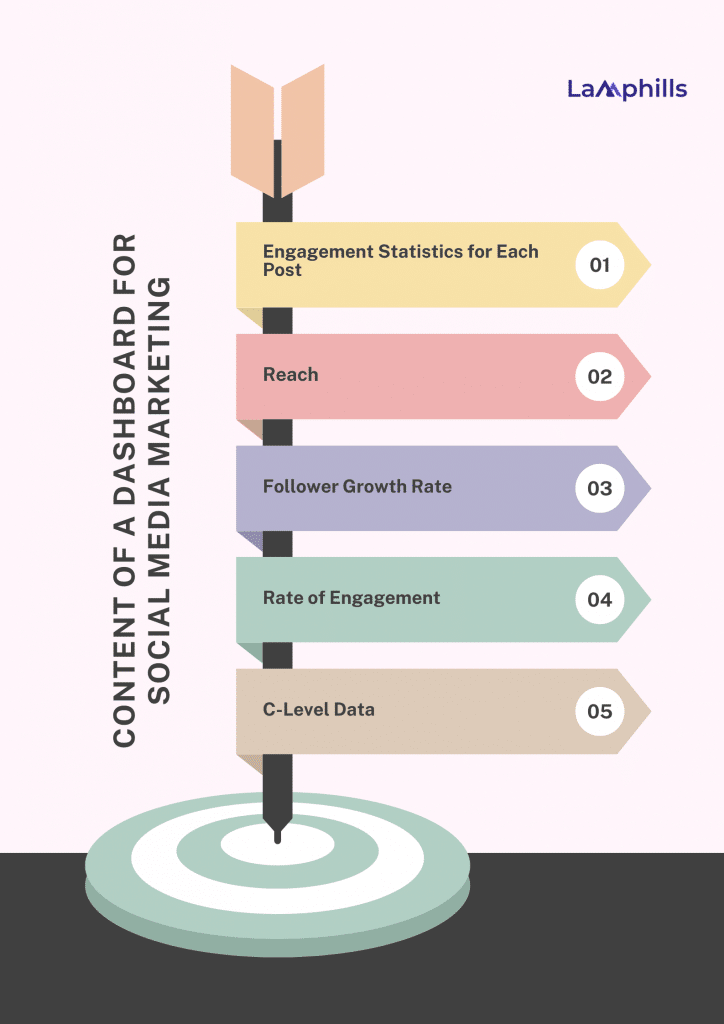Social media marketing has become essential for businesses to connect with their audience and promote their brand. To effectively manage and analyze social media efforts, many marketers use a social media marketing dashboard. This powerful tool allows you to track, measure, and analyze the performance of all your social media channels in one centralized location.
But, there is much more to social media marketing dashboard statistics than just reach, clicks, and engagement rates.
In this guide, I will explain what a social media marketing dashboard is, why it’s useful, and how I build them for brands and use them to achieve marketing goals.
In this article, I will explain what a social media dashboard is, why organizations need one in the modern business world, and what best practices entail when utilizing outside software. I will also examine real-world instances to help you comprehend the power of an efficient social media analytics dashboard.
Key Takeaways
- A social media marketing dashboard consolidates data from various platforms, allowing you to track and analyze your social media performance in one place.
- Essential metrics to monitor include engagement statistics, reach, follower growth rate, engagement rate, and C-level data that are tied to business outcomes.
- Creating an effective dashboard starts with understanding your goals and selecting relevant KPIs that align with your objectives.
- Regular check-ins and analysis of your dashboard data are crucial for adapting your strategy and improving performance over time.
- Different stakeholders may require different levels of detail in reporting, so it’s important to customize your dashboard and reports for various audiences.
What is a Social Media Marketing Dashboard?
A social media marketing dashboard is a platform that allows you to track, measure, and analyze the performance of all your social media channels in one spot. It can help you understand everything from follower growth to competition intelligence and social sentiment.
Ideally, your social media analytics dashboard should display visual representations of your data. This makes it easier to see how things change over time, making it a living document with easy comparisons.
Your social goals and team size will determine how you use a social media dashboard, which provides a high-level picture of your social performance.
What Makes a Social Media Dashboard Useful for Me?
With a social media dashboard, you can see all your important metrics simultaneously. Use your social media analytics to inform your marketing plan, interact with your target market, boost conversion rates, and make sales. Using social media dashboards, you can share your performance with your team and obtain insight quickly, helping you keep up with your social media strategy.
ROI Calculation Template.pdf
Content of a Dashboard for Social Media Marketing
Various metrics are used for various purposes. Bottom-funnel conversions are influenced by direct social purchases on social media, while impressions may signify increased brand awareness. A set of fundamental indicators must always be included on your social media dashboard, regardless of the charts and visualization methods that vary from dashboard to dashboard.
Let me review every important metric that needs to be on your dashboard. But first, check out this Improvado LinkedIn overview dashboard, which highlights all the important indicators you should be monitoring.

#1. Engagement Statistics for Each Post
This category includes all of the most popular social media metrics—likes, shares, responses, comments, and so on—and serves as a gauge for how well your posts connect with readers. Marketers use an engagement overview social dashboard as their first tool for campaign analysis, optimization, and planning.
#2. Reach
Reach is the total number of unique accounts that saw your adverts. Reach is also most commonly used to assess brand awareness. It is considered a vanity statistic that fails to demonstrate the true impact of your social initiatives on the company’s bottom line. However, if your company is expanding and targeting new audiences, you should still know how many individuals have seen your adverts. Without a focus on reach, many potential customers would never have heard of your brand, deal, or great message.
#3. Follower Growth Rate
The follower growth rate shows how quickly your social media account’s audience is increasing. It is a vital measure of how well your campaigns are performing. It also helps you understand how you compare to your competitors and analyze your brand’s predicted share of voice on social media.
#4. Rate of Engagement
An additional crucial measure for a social media dashboard is the engagement rate. It gauges how much interaction a piece of content receives about its reach or the number of followers on an account.
#5. C-Level Data
To be honest, most CEOs do not look into following growth rates or reach. They frequently lack the time to determine how these measurements affect the real success of the business. You, therefore, require a dashboard that is compatible with the language used by executives. The vocabulary of earnings.
Executive dashboards are frequently customized for each executive, enabling them to make fast decisions in their areas of specialization. Among the measures are data from competitor analyses, cost per acquisition, earned media value, share of voice, and more.
How to Create (and Use) a Social Media Dashboard
A social media dashboard provides a clear perspective of your social media performance. You can readily observe what works and what doesn’t. It also lets you track your progress and see how your material performs.
Monthly Social Media Review Checklist.pdf
Here’s how to create and use a social dashboard to help you achieve your social media goals.
#1. Understand Your Goals
Before you can track and assess your goals, you must define them clearly.
Use the SMART goal-setting framework to make your goals more explicit. The SMART goals are:
- Specific and measurable
- Achievable
- Relevant
- and time-bound
Instead of declaring your objective is to gain more social media followers, you may state that one of your goals is to raise your Instagram follower count by 5% per month. Conduct some industry benchmarking as part of your goal-setting process to ensure that your objectives are relevant and attainable.
#2. Manually Record Your Data
A manual dashboard might be an inexpensive approach to monitor social media success when you are just getting started. However, it requires more effort than the other methods.
We provide a social media report form to assist you keep track of your social data. To access the data, log into each social media platform’s analytics tools (such as Meta Business Suite and Twitter Analytics). Google Analytics allows you to collect additional conversion data.
As you collect data, simply enter it into the appropriate columns on the template. If you build a useful report, use the same period across all of your reporting tools.
#3. Determine Your Measurements and KPIs
Your measurements and KPIs are the figures you will use to track your progress toward your goals. As a result, the measurements and KPIs you select should be consistent with the language used to describe the goals. Following the example above, if you want to grow your Instagram followers, the obvious statistic is Instagram followers.
Consider indicators that can provide more in-depth insights. So, instead of merely counting your followers, it is useful to track their growth pace. This demonstrates how quickly your following count is increasing.
If you want to enhance engagement, employ social listening to monitor the sentiment of mentions and conversations. This helps you determine whether the engagement you are seeing has a positive or negative tone. You might also specify the forms of engagement you wish to increase, such as link clicks or comments.
#4. Conclude Your Data
A social media metrics dashboard shows all of your metrics in one location, making it easy to identify what is and is not working. The actual value of good social reporting is in taking the next step and acting upon your findings.
Let us take an example of a social media post that has a lot of engagement but not enough clicks. You could concentrate on producing more shareable material.
Say, rather, that you find specific times of the day when your audience is most attentive. You can change the frequency of your posts accordingly.
Let us say you see a decline in society’s general mood. Alternatively, it could be that your rivals are now outperforming you.
Before things go out of control, conducting some strategic planning and analysis is necessary to identify the problem’s origin.
Understanding your social media stats will enable you to draw in-depth conclusions. After that, you may adjust your marketing plan to boost conversions and fill the sales funnel.
#5. Use a Social Media Management Tool
A social media management application like Hootsuite will automatically track your social data across platforms. This can be a significant time saver because it eliminates the need to log into various tools to collect your information.
All you need to do is connect your social media accounts. The data will then be available whenever you open your social media dashboard. With a few clicks, you may view visual representations of your data over a specific period. This is the best social media dashboard for large social teams.
#6. Establish a Data Tracking System
A social media analytics dashboard should allow you to easily monitor your success across all of your social media outlets. The more data you can collect, the better you will be able to determine what works and what doesn’t.
You have several data tracking choices. The one you choose will be determined by the size of your team, the depth of your social presence, and the amount of time and money you are willing to devote.
#7. Discuss Your Results
Using a social media marketing dashboard, sharing your findings with stakeholders should be simple. Reporting helps support the need for additional funding by demonstrating the return on investment of your social media initiatives. Reporting is crucial for team learning whether things are going well or not.
Select a dashboard for social media reporting that enables you to create personalized reports. Extra points for scheduling reports to be sent automatically at periods that work best for your social media objectives.
Remember that different people in your reporting hierarchy will want different levels of reporting information or may not even want it. Your social media team members probably want to gather as much information as possible to spark conversation and ideas.
Data regarding inbound sentiment and messaging can be useful to your customer support team. However, they probably do not need to know each post’s engagement metrics.
Meanwhile, executives and other high-level stakeholders probably only need a high-level overview of the metrics that matter most to ROI, such as site traffic and conversions.
#8. Create a Google Looker Studio Report
Looker Studio, formerly known as Google Data Studio, is a data visualization application that can help you better analyze your social performance.
Looker Studio’s partner connectors may be used to connect your social channels to a report and generate visualizations of key social KPIs. This may seem daunting if you have never utilized Google Analytics reports. However, individuals familiar with Google’s reporting tools may find it useful.
Many of the partner connections used to automatically integrate data from social channels need a monthly charge. Another alternative is to utilize Google Looker Studio to generate a visual report using the data from your Google Sheets social media report template.
#9. Regularly Check in on Your Progress
A social media management dashboard can only greatly benefit your marketing efforts if you use it frequently. Since the social scene is constantly shifting, you cannot count on what is effective today to remain so tomorrow. Frequent check-ins will enable you to assess your progress toward your objectives. They will also function as a precursor to warning systems when circumstances begin to shift. Then, you can modify your plan as necessary.
Establishing a regular reporting plan for your progress is also a smart idea. The reporting plan must correspond with the deadlines in your established objectives. For instance, monthly reports are unquestionably ideal if your goals have a monthly deadline. To ensure everything is moving forward as planned, the main stakeholder should probably check in more frequently. You will have the best opportunity to react quickly to new successes and obstacles if you review your overview reports weekly or even daily.
What is a dashboard in social media marketing?
A social media dashboard is an instrument that compiles your vital social media data from many networks, enabling you to promptly assess the effectiveness of your campaigns and postings, customer service exchanges, and community involvement.
What does a marketing dashboard look like?
A marketing dashboard is an effective visual tool for displaying pertinent data regarding marketing metrics and key performance indicators (KPIs). Marketers can get real-time insights from various data sources and track the effectiveness of their campaigns and other marketing initiatives in one convenient location.
Conclusion
To sum up, creating a social media marketing dashboard necessitates a firm grasp of the metrics important to your professional or personal objectives, choosing the appropriate tools and services based on your needs, and developing a well-thought-out plan for data visualization and analysis. To obtain insights into audience growth rate, content performance, and campaign efficacy, the procedure includes obtaining data from multiple social media platforms, centralizing it, and utilizing analytics. A social media dashboard may help you make data-driven choices, save time, and accomplish your social media objectives more quickly with the appropriate strategy and resources.
Related Articles
- Digital Marketing Success: 10 SEO Goals Your Brand Should Target for 2024
- Social Media Strategy Templates: 10+ Free Social Media Strategy Templates to Help Your Team Save Time
- Hootsuite Alternatives: 15 Best Hootsuite Alternatives for Social Media Management in 2024
- What Is SaaS Marketing Automation? 8 Best Tools and Strategies for Your Brand
- Top Social Media Advertising Metrics Every Marketer Should Track in 2024






